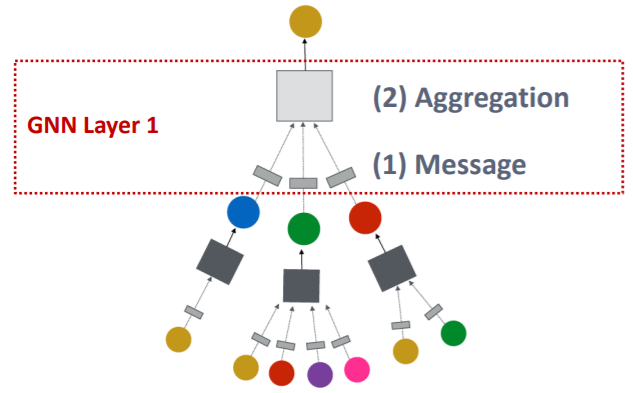Hello. I’m making Graph classification model using EdgeGATConv layer. I’m trying to understand every step but it is hard. I have several questions with my code and I need some help of experts ![]() . Here is my Code.
. Here is my Code.
1. Data Load
I sucessfully loaded data from my csv files.
dataset = dgl.data.CSVDataset('./GC')
len(dataset)
#14513
graph0, data0 = dataset[0]
print(graph0)
'''
Graph(num_nodes = 553, num_edges = 737,
ndata_schemes = {'feat' : Scheme(shape=(3,), dtype=torch.float32)}
edata_schemes = {'feat' : Scheme(shape=(2,), dtype=torch.float32)}
'''
print(data0)
#{'feat' : tensor([5790.]), 'label' : tensor([1])}
2. Train / Test split, Batch
Then I split the data as train / test and batch.
from dgl.dataloading import GraphDataLoader
from torch.utils.data.sampler import SubsetRandomSampler
num_data = len(dataset)
num_train = int(num_data * 0.8)
train_sampler = SubsetRandomSampler(torch.arange(num_train))
test_sampler = SubsetRandomSampler(torch.arange(num_train, num_data))
train_dataloader = GraphDataLoader(
dataset,
sampler = train_sampler,
batch_size = 100,
drop_last = False)
test_dataloader = GraphDataLoader(
dataset,
sampler = test_sampler,
batch_size = 100,
drop_last = False)
3. Modeling
Then I made model like this.
class EdgeGATModel(nn.Module):
def __init__(self, in_feats, edge_feats, hidden_feats, out_feats, num_heads):
super(EdgeGATModel, self).__init__()
self.edge_gat1 = EdgeGATConv(in_feats=in_feats,
edge_feats=edge_feats,
out_feats=hidden_feats,
num_heads=num_heads)
self.edge_gat2 = EdgeGATConv(in_feats=num_heads * hidden_feats,
edge_feats=edge_feats,
out_feats=hidden_feats,
num_heads=num_heads)
self.classify = nn.Linear(hidden_feats * num_heads, 1)
def forward(self, graph, node_feats, edge_feats, num_heads):
hidden1 = self.edge_gat1(graph, node_feats, edge_feats)
hidden1 = hidden1.view(hidden1.shape[0], -1)
hidden1 = F.leaky_relu(hidden1)
hidden2 = self.edge_gat2(graph, hidden1, edge_feats)
hidden2 = hidden2.view(hidden2.shape[0], -1)
hidden2 = F.leaky_relu(hidden2)
hidden2 = self.classify(hidden2)
return hidden2
4. Training and Evaluating
def train(model, dataloader):
model.train()
for batched_graph, labels in dataloader:
batched_graph = dgl.add_self_loop(batched_graph)
optimizer.zero_grad()
pred = model(batched_graph, batched_graph.ndata['feat'], batched_graph.edata['feat'], num_heads)
loss = criterion(pred, labels.float())
loss.backward()
optimizer.step()
# Code for evaluation
def evaluate(model, dataloader):
model.eval()
num_correct = 0
num_tests = 0
for batched_graph, labels in dataloader:
batched_graph = dgl.add_self_loop(batched_graph)
with torch.no_grad():
pred = model(batched_graph, batched_graph.ndata['feat'], batched_graph.edata['feat'], num_heads)
pred_labels = (torch.sigmoid(pred) >= 0.5).squeeze().long()
num_correct += (pred_labels == labels).sum().item()
num_tests += len(labels)
accuracy = num_correct / num_tests
return accuracy
# Create train and test dataloaders using SubsetRandomSampler
train_sampler = SubsetRandomSampler(torch.arange(num_train))
test_sampler = SubsetRandomSampler(torch.arange(num_train, num_data))
train_dataloader = GraphDataLoader(dataset, sampler=train_sampler, batch_size=100, drop_last=False)
test_dataloader = GraphDataLoader(dataset, sampler=test_sampler, batch_size=100, drop_last=False)
# Initialize your model
model = EdgeGATModel(in_feats=3, edge_feats=2, hidden_feats=64, out_feats=1, num_heads=3)
# Define your loss function
criterion = nn.BCEWithLogitsLoss()
# Define your optimizer
optimizer = torch.optim.Adam(model.parameters(), lr=0.001)
# Perform training for epochs
from tqdm import tqdm
for epoch in tqdm(range(10), desc="Training Epochs"):
train(model, train_dataloader)
accuracy = evaluate(model, test_dataloader)
print(f"Epoch: {epoch+1}, Test accuracy: {accuracy}")
1st question :
My goal is to make 2-step layer like this.

Is it right to make layers like what I did? I’m not sure about the multi - head attention concept.
EX) 8 nodes with 20 featrues (8,20) → multi head(3) attention with 15 hidden features → (8, 3, 15) → reshape → (8, 45) → Average ? or just use this as input of layer2 ?
2nd question:
I’m facing error with loss calculation. How should I fix the code to make same shape of my pred and label?
Thanks for reading. I really appreciate for any apply or advice.
